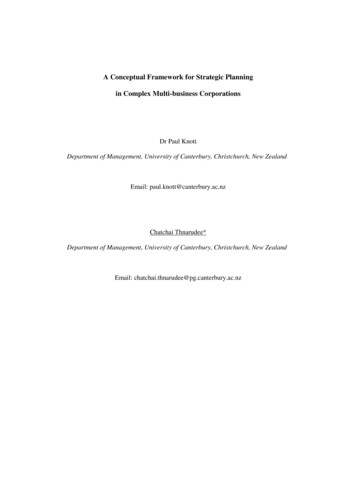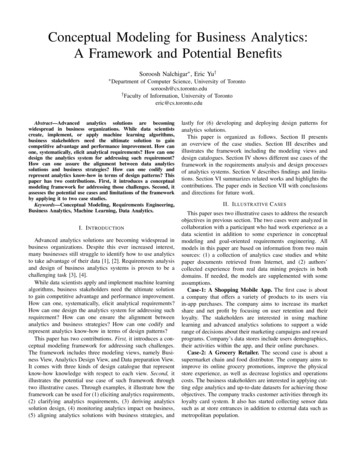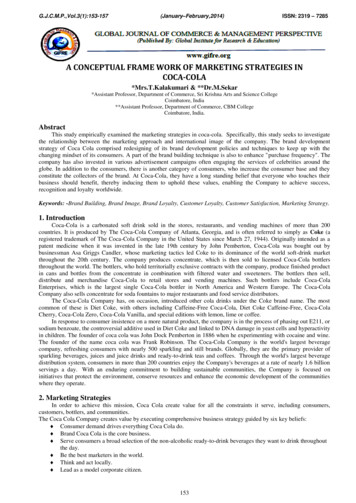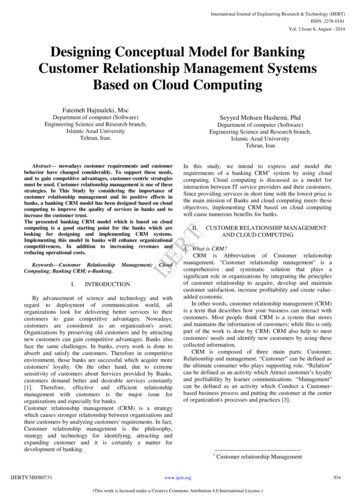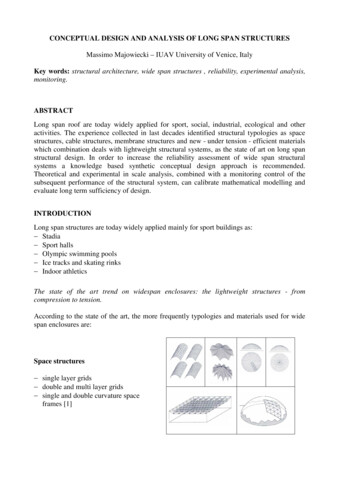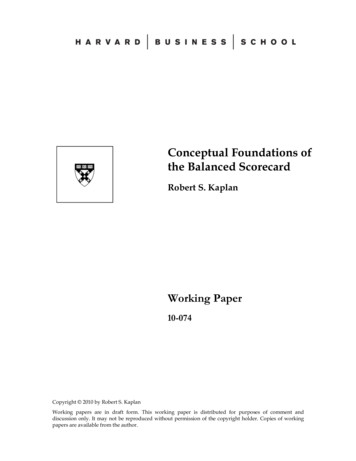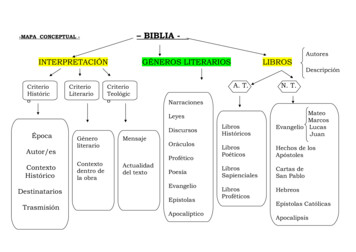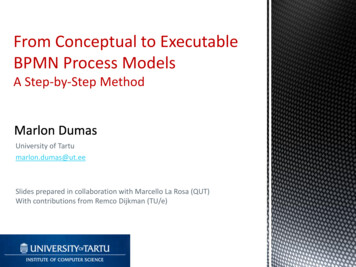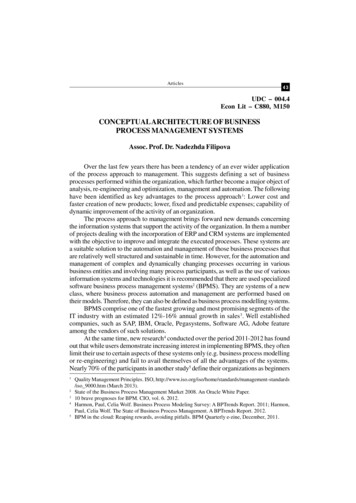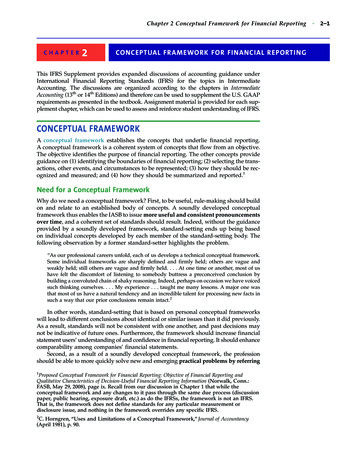
Transcription
Chapter 2 Conceptual Framework for Financial ReportingCHAPTER2CONCEPTUAL FRAMEWORK FOR FINANCIAL REPORTINGThis IFRS Supplement provides expanded discussions of accounting guidance underInternational Financial Reporting Standards (IFRS) for the topics in IntermediateAccounting. The discussions are organized according to the chapters in IntermediateAccounting (13th or 14th Editions) and therefore can be used to supplement the U.S. GAAPrequirements as presented in the textbook. Assignment material is provided for each supplement chapter, which can be used to assess and reinforce student understanding of IFRS.CONCEPTUAL FRAMEWORKA conceptual framework establishes the concepts that underlie financial reporting.A conceptual framework is a coherent system of concepts that flow from an objective.The objective identifies the purpose of financial reporting. The other concepts provideguidance on (1) identifying the boundaries of financial reporting; (2) selecting the transactions, other events, and circumstances to be represented; (3) how they should be recognized and measured; and (4) how they should be summarized and reported.1Need for a Conceptual FrameworkWhy do we need a conceptual framework? First, to be useful, rule-making should buildon and relate to an established body of concepts. A soundly developed conceptualframework thus enables the IASB to issue more useful and consistent pronouncementsover time, and a coherent set of standards should result. Indeed, without the guidanceprovided by a soundly developed framework, standard-setting ends up being basedon individual concepts developed by each member of the standard-setting body. Thefollowing observation by a former standard-setter highlights the problem.“As our professional careers unfold, each of us develops a technical conceptual framework.Some individual frameworks are sharply defined and firmly held; others are vague andweakly held; still others are vague and firmly held. . . . At one time or another, most of ushave felt the discomfort of listening to somebody buttress a preconceived conclusion bybuilding a convoluted chain of shaky reasoning. Indeed, perhaps on occasion we have voicedsuch thinking ourselves. . . . My experience . . . taught me many lessons. A major one wasthat most of us have a natural tendency and an incredible talent for processing new facts insuch a way that our prior conclusions remain intact.2In other words, standard-setting that is based on personal conceptual frameworkswill lead to different conclusions about identical or similar issues than it did previously.As a result, standards will not be consistent with one another, and past decisions maynot be indicative of future ones. Furthermore, the framework should increase financialstatement users’ understanding of and confidence in financial reporting. It should enhancecomparability among companies’ financial statements.Second, as a result of a soundly developed conceptual framework, the professionshould be able to more quickly solve new and emerging practical problems by referring1Proposed Conceptual Framework for Financial Reporting: Objective of Financial Reporting andQualitative Characteristics of Decision-Useful Financial Reporting Information (Norwalk, Conn.:FASB, May 29, 2008), page ix. Recall from our discussion in Chapter 1 that while theconceptual framework and any changes to it pass through the same due process (discussionpaper, public hearing, exposure draft, etc.) as do the IFRSs, the framework is not an IFRS.That is, the framework does not define standards for any particular measurement ordisclosure issue, and nothing in the framework overrides any specific IFRS.2C. Horngren, “Uses and Limitations of a Conceptual Framework,” Journal of Accountancy(April 1981), p. 90.·2–1
2–2·IFRS Supplementto an existing framework of basic theory. For example, Sunshine Mining (USA) soldtwo issues of bonds. It can redeem them either with 1,000 in cash or with 50 ounces ofsilver, whichever is worth more at maturity. Both bond issues have a stated interest rateof 8.5 percent. At what amounts should Sunshine or the buyers of the bonds record them?What is the amount of the premium or discount on the bonds? And how should Sunshineamortize this amount, if the bond redemption payments are to be made in silver (thefuture value of which is unknown at the date of issuance)? Consider that Sunshine cannotknow, at the date of issuance, the value of future silver bond redemption payments.It is difficult, if not impossible, for the IASB to prescribe the proper accountingtreatment quickly for situations like this or like those represented in our opening story.Practicing accountants, however, must resolve such problems on a daily basis. How?Through good judgment and with the help of a universally accepted conceptual framework, practitioners can quickly focus on an acceptable treatment.Development of a Conceptual FrameworkBoth the IASB and the FASB have a conceptual framework. The IASB’s conceptualframework is described in the document, “Framework for Preparation and Presentation of Financial Statements.” The FASB’s conceptual framework is developed ina series of concept statements, which is generally referred to as the ConceptualFramework. The IASB and the FASB are now working on a joint project to developan improved common conceptual framework that provides a sound foundation fordeveloping future accounting standards. [1]3 Such a framework is essential to fulfilling the Boards’ goal of developing standards that are principles-based, internallyconsistent, and internationally converged, and that lead to financial reporting thatprovides the information investors need to make sound and effective decisions.The new framework will build on the existing IASB and FASB frameworks, andconsider developments subsequent to the issuance of these frameworks. To date, theproject has identified the objective of financial reporting (discussed in Chapter 1) andthe qualitative characteristics of decision-useful financial reporting information.Overview of the Conceptual FrameworkIllustration 2-1 provides an overview of the IASB’s conceptual framework, also referredto as the Framework.The first level identifies the objective of financial reporting—that is, the purposeof financial reporting. The second level provides the qualitative characteristics thatmake accounting information useful and the elements of financial statements (assets,liabilities, and so on). The third level identifies the recognition, measurement, and disclosure concepts used in establishing and applying accounting standards and the specificconcepts to implement the objective. These concepts include assumptions, principles,and constraints that describe the present reporting environment. We examine thesethree levels of the Framework next.FIRST LEVEL: BASIC OBJECTIVEThe objective of financial reporting is the foundation of the Framework. Other aspectsof the Framework—qualitative characteristics, elements of financial statements, recognition, measurement, and disclosure—flow logically from the objective. Those aspects ofthe Framework help to ensure that financial reporting achieves its objective.The objective of general-purpose financial reporting is to provide financial information about the reporting entity that is useful to present and potential equity investors,3The FASB Conceptual Framework is contained in seven concepts statements, which areaccessible at the FASB website (http://www.fasb.org/st/#cons). Information on the joint conceptualframework project can be found at http://www.fasb.org/project/conceptual framework.shtml.
Chapter 2 Conceptual Framework for Financial Reporting·2–3ILLUSTRATION 2-1Framework for FinancialReportingThird level:The "how"—implementationRecognition, Measurement, and Disclosure ond level: Bridge betweenlevels 1 and 3First level: The "why"—purposeof accountinglenders, and other creditors in making decisions in their capacity as capital providers.Information that is decision-useful to capital providers may also be useful to otherusers of financial reporting, who are not capital providers.4As indicated in Chapter 1, to provide information to decision-makers, companiesprepare general-purpose financial statements. General-purpose financial reportinghelps users who lack the ability to demand all the financial information they need froman entity and therefore must rely, at least partly, on the information provided in financial reports. However, an implicit assumption is that users need reasonable knowledgeof business and financial accounting matters to understand the information containedin financial statements. This point is important. It means that financial statement preparers assume a level of competence on the part of users. This assumption impacts theway and the extent to which companies report information.SECOND LEVEL: FUNDAMENTAL CONCEPTSThe objective (first level) focuses on the purpose of financial reporting. Later, we willdiscuss the ways in which this purpose is implemented (third level). What, then, is thepurpose of the second level? The second level provides conceptual building blocks4“Chapter 1, The Objective of Financial Reporting,” Proposed Conceptual Framework for FinancialReporting: Objective of Financial Reporting and Qualitative Characteristics of Decision-UsefulFinancial Reporting Information (Norwalk, Conn.: FASB, May 2008).
2–4·IFRS Supplementthat explain the qualitative characteristics of accounting information and define theelements of financial statements.5 That is, the second level forms a bridge between thewhy of accounting (the objective) and the how of accounting (recognition, measurement,and financial statement presentation).Qualitative Characteristics of Accounting InformationShould companies like Cathay Pacific Airways Ltd. (HKG) or Nippon Steel (JPN)provide information in their financial statements on how much it costs them to acquire their assets (historical cost basis) or how much the assets are currently worth(fair value basis)? Should PepsiCo (USA) combine and show as one company the fourmain segments of its business, or should it report PepsiCo Beverages, Frito Lay,Quaker Foods, and PepsiCo International as four separate segments?How does a company choose an acceptable accounting method, the amount andtypes of information to disclose, and the format in which to present it? The answer: Bydetermining which alternative provides the most useful information for decisionmaking purposes (decision-usefulness). The IASB identified the qualitative characteristics of accounting information that distinguish better (more useful) informationfrom inferior (less useful) information for decision-making purposes. In addition, theIASB identified certain constraints (cost and materiality) as part of the conceptual framework (discussed later in the chapter). As Illustration 2-2 shows, the characteristics maybe viewed as a hierarchy.ILLUSTRATION 2-2Hierarchy of AccountingQualitiesCAPITAL PROVIDERS (Investors and Creditors)AND THEIR CHARACTERISTICSPrimary users ofaccounting informationConstraintsCOSTPervasive criterionFundamentalqualitiesIngredients abilityFAITHFUL tenessTimelinessNeutralityFree from errorUnderstandabilityAs indicated by Illustration 2-2, qualitative characteristics are either fundamentalor enhancing characteristics, depending on how they affect the decision-usefulness ofinformation. Regardless of classification, each qualitative characteristic contributes tothe decision-usefulness of financial reporting information. However, providing useful5“Chapter 2, Qualitative Characteristics and Constraints of Decision-Useful FinancialReporting Information,” Proposed Conceptual Framework for Financial Reporting: The Objectiveof Financial Reporting and Qualitative Characteristics and Constraints of Decision-Useful FinancialReporting Information (Norwalk, Conn.: FASB, May 2008), paras. QC7–QC38.
Chapter 2 Conceptual Framework for Financial Reportingfinancial information is limited by two pervasive constraints on financial reporting—cost and materiality.Fundamental Quality—RelevanceRelevance is one of the two fundamental qualities that make accounting informationuseful for decision-making. Relevance and related ingredients of this fundamental quality are shown below.FundamentalqualityIngredients of rmatoryvalueTo be relevant, accounting information must be capable of making a difference in adecision. Information with no bearing on a decision is irrelevant. Financial information iscapable of making a difference when it has predictive value, confirmatory value, or both.Financial information has predictive value if it has value as an input to predictiveprocesses used by investors to form their own expectations about the future. For example, if potential investors are interested in purchasing ordinary shares in Stora Enso(NLD), they may analyze its current resources and claims to those resources, its dividend payments, and its past income performance to predict the amount, timing, anduncertainty of Stora Enso’s future cash flows.Relevant information also helps users confirm or correct prior expectations; it hasconfirmatory value. For example, when Stora Enso issues its year-end financial statements, it confirms or changes past (or present) expectations based on previous evaluations. It follows that predictive value and confirmatory value are interrelated. Forexample, information about the current level and structure of Stora Enso’s assets andliabilities helps users predict its ability to take advantage of opportunities and to react toadverse situations. The same information help
Hierarchy of Accounting Qualities As indicated by Illustration 2-2, qualitative characteristics are either fundamental or enhancing characteristics, depending on how they affect the decision-usefulness of information. Regardless of classification, each qualitative characteristic contributes to the decision-usefulness of financial reporting information. However, providing useful . Chapter 2 .
